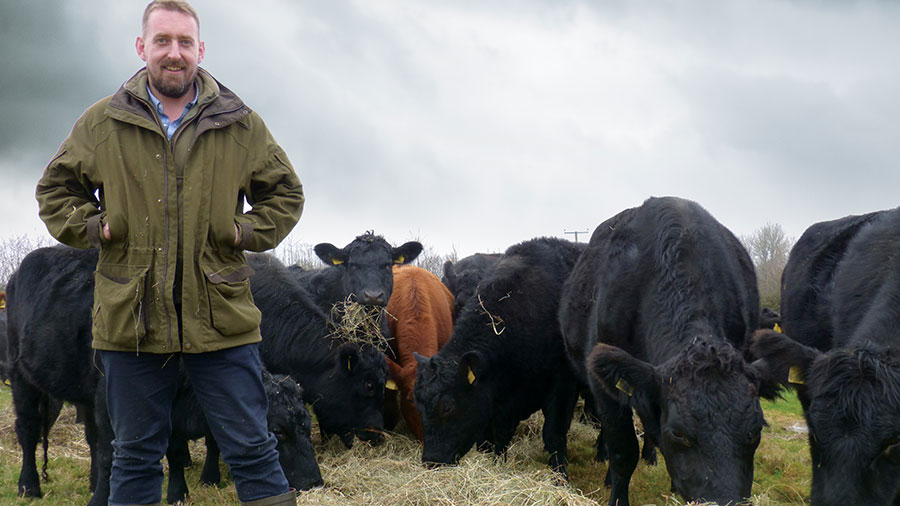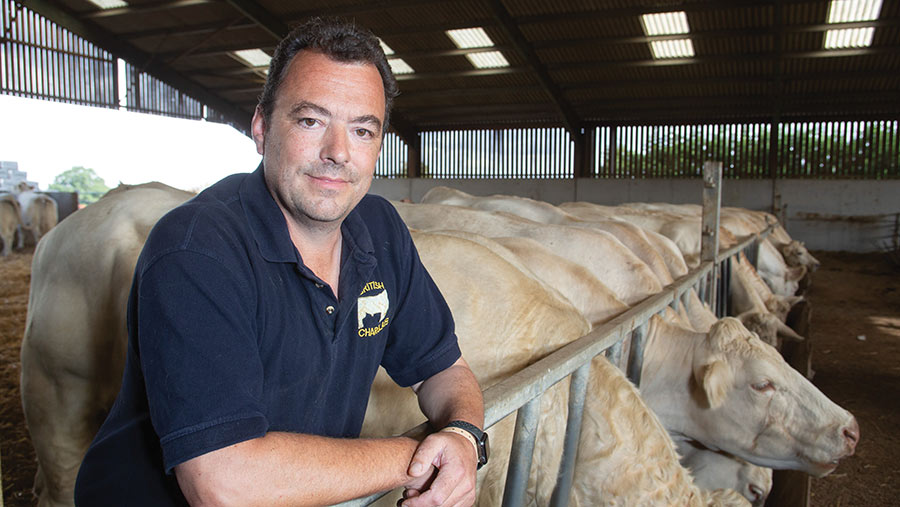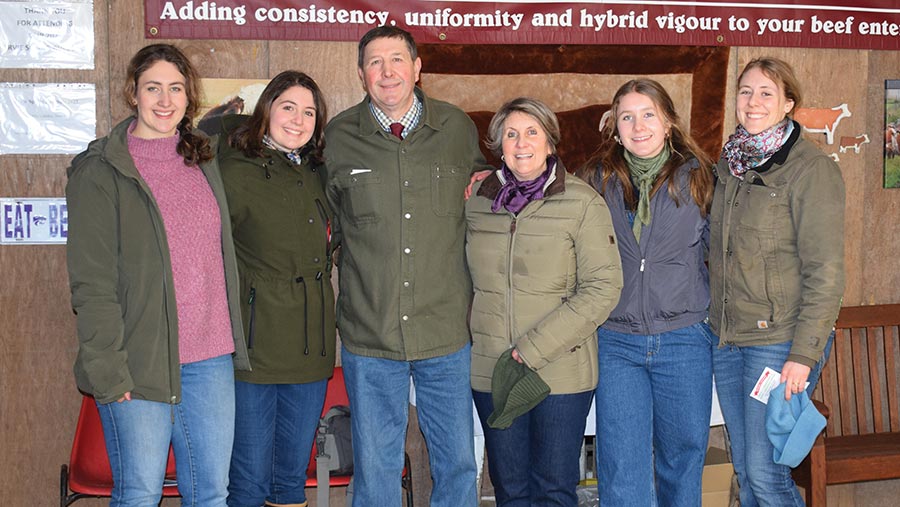How three breeders market their bulls
Livestock marketing has come on in leaps and bounds, with the internet opening up a global audience for bulls and sales moving online.
We speak to three breeders about their marketing strategies.
See also: Rival breeders’ collaboration sees Angus bull sales treble
Rob Havard, Phepson Angus, Droitwich, Worcestershire

Rob Harvard with his Phepson Angus herd © Michael-Priestley
A regenerative system with practically no inputs other than a salt and mineral lick and electric fencing has been a major attraction for a growing number of customers of Rob Havard’s Phepson Angus herd.
Mr Havard bought his first pedigree Angus in 2013 and first sold bulls in 2017. He stresses it is still “early days” and sees what he is doing as a 30-year project to breed cattle that thrive on such low inputs.
Expecting to calve 100 cows this year, and oversubscribed two or three times for bulls and females already, Phepson Angus is growing its herd through a collaborative agreement with three other breeders.
A further two herds are ready to join next year.
Starter herds have been sold to like-minded farmers and bulls are bought back from these breeders each year, but rather than paperwork and contracts, the agreement is based on good working relationships and aligned systems and aims, says Mr Havard.
Breeder Q&A
Do you sell anything online?
No, just farm-to-farm sales. Last year every bull was valued at £3,750.
What’s your unique selling point?
The system we run here is a huge marketing feature. We calve outdoors, it’s zero-input, holistic mob-grazing with a compact, native-type Angus. All cows and bulls get is pasture and bales of hay.
We have used bulls and females from a variety of native-type herds.
Cattle go back to bulls such as Evesund of Dupplin, Betro of Classlochie and Dunlouise Gypsy Earl. Eddisbury genetics have also worked well.
Line breeding means slightly suppressed growth and performance for us at home, but offers a genuine outcross for our customers, bringing greater heterosis and performance for them.
Do you attend society sales?
No, we rely on developing relationships with like-minded farmers interested in our system.
Do you advertise?
We had a stand at Groundswell this year to target the progressive regenerative arable farming market.
We ordered branded Hawaiian shirts and handed some out on the stand. It worked really well and was a change from caps or a branded gilet.
Any embryo or semen sales?
We’ve sold Kaiser straws across the UK and into the Netherlands, with 2,000 straws recently sold to Argentina for their grass-fed market.
We are interested to see how this market develops in the coming years.
How much showing do you do?
Currently none.
Do you have an online presence?
Yes, we put most things on Twitter and took over the Farmers of the UK Twitter page earlier this year. We also have a website, phepsonangus.com
Is the herd performance-recorded?
At calving we record fertility, calving ease, udder and foot score. Any cows that cause a problem or need intervention are marked for culling.
But we don’t performance-record with Breedplan.
Ben Harman, Chesham and Silver Charolais herds, Buckinghamshire

© Tim Scrivener
A conscious effort to produce functional, easy-calving, short gestation bulls for suckler farmers has opened up the dairy market for the Harman family at Chesham, Bucks.
Ben Harman is targeting the dairy artificial insemination (AI) market with Silver Oakman at about £5/straw (depending on volume) but a £500 royalty fee is charged to limit pedigree interest.
Balthayock Musketeer is targeted at the pedigree market (£30/straw with a £30 royalty fee).
About 15-20 bulls are sold annually, about half of which are sold off farm, with straw sales roughly equivalent in value to selling one bull each month.
One buyer is acquiring most of the 40-cow herd (second calvers and older) this October.
Bulls are penned on value (A,B and C) and picked out by breeders. No haggling is done. Better bulls are taken to Welshpool and the cream are sold at Stirling.
Breeder Q&A
Do you sell anything online?
Other than getting bulls into stud, no. We sell in the auction ring or privately. We try to deliver every bull ourselves personally.
What’s your unique selling point?
I am lucky as we are the oldest British Charolais herd. I have my grandfather and father’s shoulders to stand on.
We’ve also been able to buy in great genetics, such as Thrunton Fairfax. He really clicked with our cows, and then Balthayock Musketeer worked well on top of Fairfax.
Do you attend Society sales?
Yes – Stirling, Welshpool, and occasionally Carlisle.
Do you advertise?
Advertising is mainly through word of mouth and the fact we are well established. Repeat custom is a delight to have.
Any embryo or semen sales?
Yes, Silver Oakman and Balthayock Musketeer.
How much showing do you do?
Pre-sale shows and local shows, and I am fortunate to be asked to judge cattle too.
Do you have an online presence?
I talk about the cows a lot on my own personal Facebook page, but it’s a soft sell.
Is the herd performance recorded?
Yes – through Breedplan with the Society. We breed short-gestation, easy- calving stock with the growth estimated breeding values (EBVs) the breed is known for. We need docile, shapely cattle.
John Douglas, Ervie Line One Herefords, Stranraer

© John Douglas
One of the UK’s few on-farm bull sales takes place each February at Mains of Airies, where buyers travel to south-west Scotland to buy Hereford bulls from the Douglas family.
Low birthweights (32kg-42kg), short gestation, uniformity, and forage-based genetics from a linebred system, attracts Black Baldy breeders, suckler farmers and dairies.
The first on-farm sale took place in 2010 when 18 bulls were sold on the day.
Now the family sells about 80 bulls annually, with half sold at the farm sale, conducted by Harry Begg, C&D Auction Marts.
The farm runs up to 230 cows, although 100 were sold in 2020 and 90 will be marketed this year through a racehorse-style sale over two days (12-14 October) with online bidding and in-person bids and a “buy now” price on all animals.
A production sale of the farm’s Texel ewes will be held on 23 September at Dumfries mart, which will also be streamed on a webcam.
Every sale has been successful, but John Douglas, his wife Alexandra and their four daughters Rosie, Ellen, Olivia and Kristina, say there are always nerves beforehand and huge relief afterwards.
Breeder Q&A
Do you sell anything online?
Yes, we have used The Livestock Link, which is a website run by in-laws in the US, for two years. We sold 11 bulls online in February. The upset price starts at £1,900.
Some breeders buy off figures, our reputation, and a 30-second video of the bull’s locomotion. Videos are important to give an honest representation of the animal.
What’s your unique selling point?
We have imported Line One Herefords which come from a herd in Montana that are linebred (35% inbred) in a very low-input system in a harsh environment.
Cows are linebred at Ervie, which means lower performance because of a lack of heterosis at home, but greater heterosis and hybrid vigour for commercial customers.
Do you attend Society sales?
Historically at Hereford, Perth and Stirling, but not for 25 years.
Do you advertise?
Yes, we advertise in the farming press, and we send postal leaflets to customers, sometimes tailoring them to beef or dairy farms.
We send a reminder a month before the sale and another a week before
Any embryo or AI sales?
We have marketed Ervie Classic S30 through Cogent and into Ireland.
How much showing do you do?
We are not focused on the showring, although we have enjoyed local shows in the past.
Do you have an online presence?
Limited 4G signal means we don’t do Twitter, but the herd is on Facebook. We always try and link to our website ervieherefords.co.uk so people can read up in detail about what we do.
Is the herd performance recorded? Yes, since the 1970s, and now using the Breedplan system, although the imported US genetics take two years to prove themselves, so figures look artificially low.
